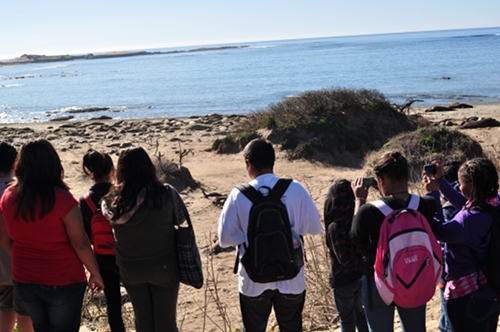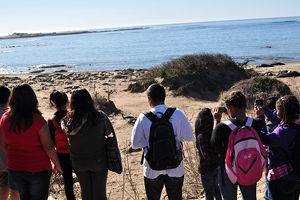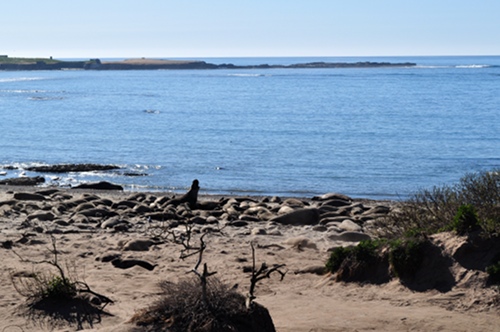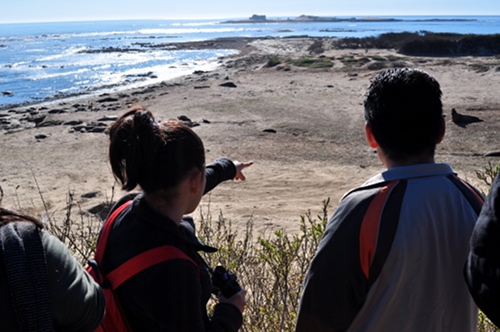
Oakland middle school students observe elephant seal behavior—and snap cell phone photos—at Año Neuvo State Reserve.
This weekend, I went to Año Nuevo State Reserve to see the elephant seals, along with 14 Oakland middle schoolers. Some friends at The Lawrence Hall of Science, where I work, needed an extra driver for a field trip. I’d never been to Año Nuevo before, so I volunteered. We had a great trip—warm weather, a terrific tour guide, and plenty of animals to observe. Those perceptive middle schoolers narrowed in on a few salient facts about elephant seal life.
We took a guided walk through the sand dunes with a docent named Bob. He started and ended the tour with poems by John Muir, peppered the kids with questions, and told us some amazing info about elephant seals. He had elephant seal whiskers in his pocket, and a piece of molted skin, which he passed around to the students. They were simultaneously repulsed and fascinated. After two hours in the warm sun, peering at elephant seals through binoculars and snapping photos with cell phones, we were headed back. During our long walk from the beach to the parking lot, I asked a few kids what they found most interesting about the elephant seals. And when we got back the parking lot, we asked the kids to share with a partner what they learned about the seals, and what they still wondered. Here are the top three things that middle schoolers noticed about elephant seals.
1. Elephant seals mate. Right in front of you. And… it’s sort of violent. Males move in on the females, and sometimes bite them so they won’t struggle. As our tour guide explained, pregnant female elephant seals come onshore to give birth in December. When they head out to sea a few months later, they’re pregnant again. They’ll return to Año Nuevo and repeat the process again next year. As one girl put it, “I wouldn’t like to have a baby every year. And I wouldn’t like it if I couldn’t pick who dad would be.” From the sounds of some of those female elephant seals, they may feel the same way.
2. Elephant seal moms are mean. They nurse their babies for about a month, and then leave the babies to fend for themselves. Elephant seal milk is super fatty—the pups gain up to 250 pounds during their month of nursing. Once they’re fattened up, the moms take off. The pups are then called weaners, and they live off their fat while they learn to swim and fish for themselves. About 50% of the weaners will survive the year. However, some weaners don’t even make it off the beach. We saw a skinny-looking little elephant seal, all alone, making meager movements of its flippers to flick sand onto its body to keep cool. It was forlorn and wrinkly, not glossy, fat, and round like its neighbors. Bob said it probably wouldn’t survive. It likely got separated from its mother before it had gotten fat enough to get through the weeks without food. The students were really upset about the fact that we were standing on the sand dunes, basically watching this little elephant seal die.


